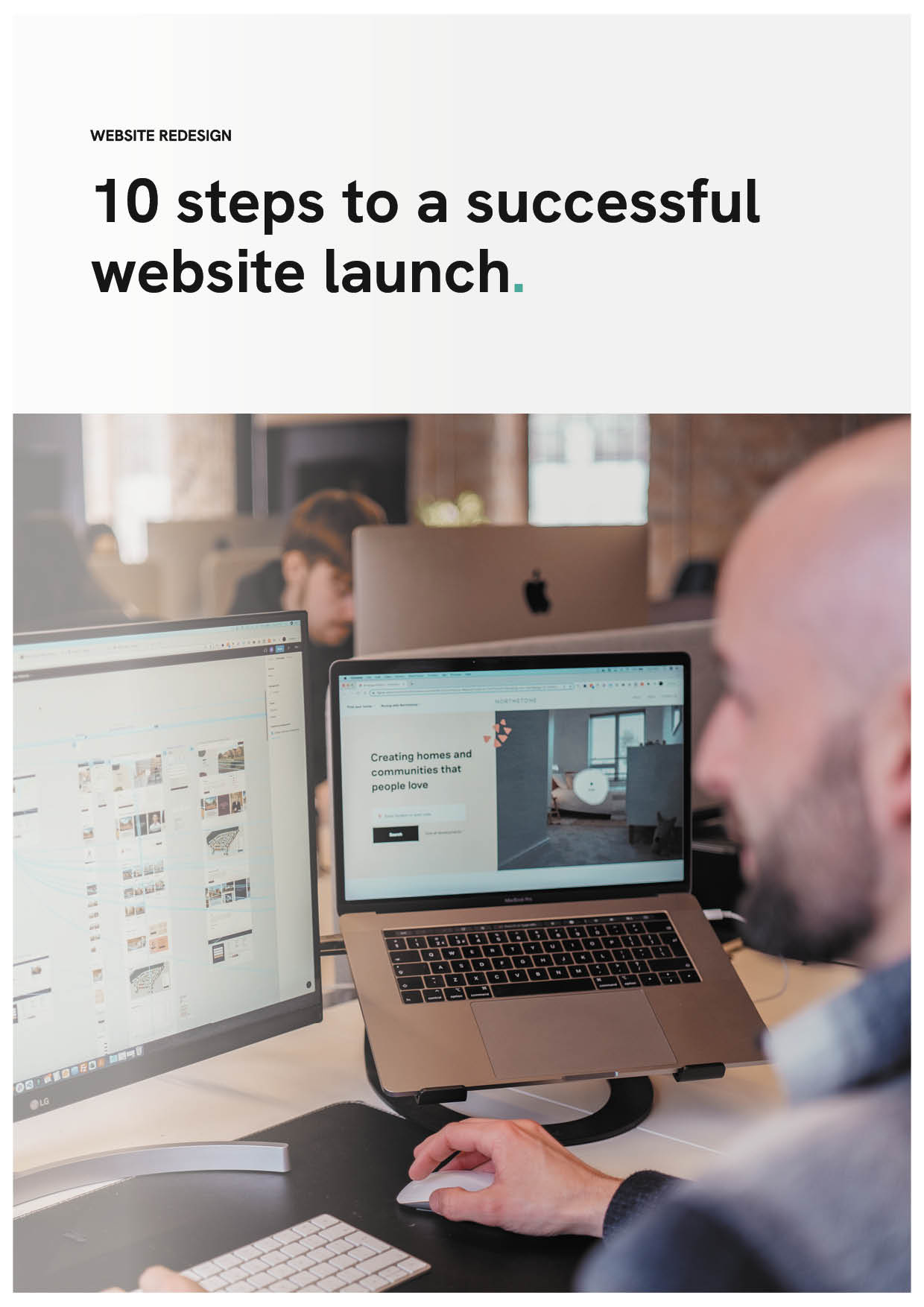A website redesign is a very big project for any business.
It’s also a very important task to get right. The absolute worst case scenario for a company is going through the long and arduous process of a complete redesign that can sometimes be very costly and launching it late, going over budget or failing to achieve the results you wanted.

Saying that, don’t be deterred from starting. A redesign is a perfect opportunity to analyse and evaluate what you already have. It’s a chance for you to audit the look, feel, content and journey your current website has and determine what your new one needs to do, who it is for and what needs to change.
So where to start? Firstly, ask yourself one simple question.
Why am I redesigning my website?
It seems like an obvious question, but it’s astounding how many website rebuilds go wrong or perform poorly because the reasons for starting were flawed. The most important thing before starting is to fully review your current website:
What problems does your current website have? (if any)
While it is fairly common for a business to update their website regularly, this can usually be just to keep the product lists up to date or to change their logo; these don’t really require a redesign.
For a full redesign to be necessary, drastic and wide-ranging changes must be needed in one or all of the following areas:
- The overall look and feel of multiple pages within your website
- The software that runs the website
- The user experience (UX), e.g how visitors interact with your website
The scope and resources required are sometimes quite large, especially for websites that have commercial features such as a store, an online resource centre or other advanced elements. These things can make it very difficult to attempt yourself if you don’t have the technical know-how.
Does your website perform as expected?
It’s entirely possible that the appearance of your website is acceptable, but it’s still not converting prospects into leads and customers. This could be for a variety of reasons. Sometimes it becomes clear that a redesign of your website is necessary just to keep up with the times and not be overtaken by competitors, or to match a new customer expectation.
So, with that in mind, let’s discuss a couple of performance related reasons why you might decide to redesign your website:
- Your customers’ needs have changed. There is one universal truth and that is people change; and so do their wants and needs as consumers of products and services. In the modern age, with technology moving and evolving so rapidly, the changing expectations of customers has become one of the most common reasons for a business to redesign their website.
- Technology has advanced. As the way customers visit a website and consume the content advances, so must the way the website functions in order to cater to these steps forward. As buyers spend more and more time on their phones, tablets and laptops, the more critical it becomes for businesses to redesign and optimise to suit mobile devices in order to increase conversion rates.
There are a plethora of other reasons why you might decide it’s in your business’ interest to redesign your website. If you would like to dig deeper into the topic and make sure you really need to go ahead, see our checklist below:
Creating a Strategy for your Redesign.
So, you’ve decided to move forward with a redesign. Now it’s time to create a strategy and plan some attainable goals along with how you will carry them out.
Firstly, you need to assess the state of your current website (yes, again!) but this time look at your metrics. This will help you to determine:
- Who visits your website, and in what numbers (Also where they navigate to the website from)
- What they whilst they are there (Which pages they visit, how long they stay on each page)
- How they consume your content (Which device they use and what browser they used to visit)
- Which keywords are most commonly used to find your website (this will help determine what keywords to include in future content)
Writing a Website Redesign Proposal.
Before you can put anything into action, it’s also vital to properly prepare a plan. For this, we recommend using the ‘SMART Goal Strategy’:
- Specific – your goals for the project need to be clear and well defined and everyone needs to aware of exactly what you are trying to achieve.
- Measurable – the goals and expectations of the project must be reasonably obtainable and everyone working on it should know how far away they are from completion of the project.
- Agreed Upon – every stakeholder throughout the process should have previously agreed what the goals are going to be.
- Realistic – the project must fit in with the availability of the business’ resources, whether that is budget and/or time constraints. Each goal should be achievable by the person responsible for it.
- Time Based – the project must have reasonable deadlines, with enough time to achieve the desired goal. A potential pitfall being giving too much time, which can also negatively affect the overall effectiveness of the project.
SMART goal setting will bring structure and simple trackability to your projects’ goals and objectives. It will present clear milestones at every stage of the project that are attainable and accurately costed. It also breeds transparency as it clarifies the way each goal came into existence and the desired end result.
Costing a Redesign.
“That’s all very well and good, but how much will it cost?” I hear you ask.
In short, it’s not a simple question to answer by any means. There are a lot of variables that make up a final price for a website rebuild, but with the help of this page and the blogs below we will demonstrate everything that will influence the final figure.
Purpose, Ambitions and Budget.
The first question that should be asked when costing a website redesign is what is the purpose of the website? What does the business want it to do?
For example, if you are a company that sells its services predominantly offline, then your website will serve as more of a shop window designed to inform and may not need complex features such as a bespoke design and functionality.
However, if you want to produce a website that is designed to educate, inform or attract and convert prospects or if you buy and sell your products and services online, something more multifaceted and unique could be necessary. This is in order to stand out from the competition but also remain ahead of the curve on extra features designed to make your customers’ experience more memorable.
The more complex your project becomes, the more it generally costs.
Who Should Redesign Your Website?
With 63% of companies stating that generating traffic and leads was the biggest marketing challenge they face, having a website that reliably does that job in the background is ever increasingly sought after.
Imagine having a highly successful sales rep that works 24/7, does not ask for a salary or commission, asks only for a one-time payment at the very start of their employment and tells you they will work for you as long as you wish. That is essentially what a well designed and budgeted website can do for a business.
This is why it is crucial to choose the correct people to design it.
So, you have three choices here; doing it yourself, hiring a freelancer or hiring an agency. All have their advantages and disadvantages.
Doing it Yourself.
If you choose to start yourself, there are many solutions out there such as Weebly, Wix and SquareSpace, which make it a lot simpler with a variety of helpful user guides and support along with a drag and drop interface designed to build the website for you without the need to learn code.
Of course, depending on the size of the project, creating a website by yourself can be a daunting task and if you are the business owner, it can sometimes end up on the backburner in favour of customers and running the business itself.
Hiring a Freelancer.
Generally, a freelancer will be a one-man band, who has specialist knowledge in a certain aspect of web design. They will offer a greater level of customisation; allowing you to achieve more from a design and functionality perspective than if you were to use a template software on your own steam.
When working with a freelancer, you can also expect a higher level of design capability and the resulting website will be high quality without any major flaws. They will usually listen to your strategy and plans, compile some simple mockups and then build on to the one you like the most.
Sometimes, however, freelancers can be a victim of their own success. Because they are a one person outfit, they can end up taking on too much work in an attempt to gain more clients, which can impact their quality of work and extend the time it takes to complete projects.
Hiring an Agency.
Usually, the ideal scenario when considering a website redesign is to hire an agency. In the vast majority of cases, they offer the best value for money and the most varied skill set of the options available. Of course, as you would expect, a redesign from an agency will be the most expensive.
What generally sets agencies apart from the other options is the amount of resources available to them- an agency will have people that specialise in areas of design, search engine optimisation, user experience, lead generation, content creation, and all the other things that a professionally designed website would require.
This ability to become a one-stop shop is a trait unique to an agency as they are large enough to spread work throughout the team evenly; which results in work being completed at a much faster rate than a freelancer- who may have multiple projects to work on at once- would be able to achieve.
Contrary to what some believe, a website is not a one and done thing, no matter how big or small the project might be. This is especially true for larger businesses and publicly traded companies, who publish press releases and company information regularly and need to keep up with evolving technology.
Hiring an agency will usually include the option of a monthly retainer that will help with sites that need regular maintenance and updates.
Think Before you Leap.
We hope this overview and the associated resources and insights have given you a much deeper understanding of the challenges you might face throughout the long process of a website redesign.
Overall, the concept that you need to get your head around is to constantly remind yourself of the important goals for your company at every stage of the project and proceed from there.

